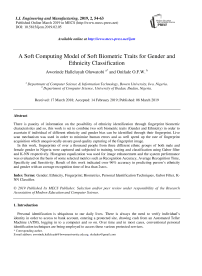A soft computing model of soft biometric traits for gender and ethnicity classification
Автор: Aworinde Halleluyah Oluwatobi, Onifade O.F.W.
Журнал: International Journal of Engineering and Manufacturing @ijem
Статья в выпуске: 2 vol.9, 2019 года.
Бесплатный доступ
There is paucity of information on the possibility of ethnicity identification through fingerprint biometric characteristics and so, this work is set to combine two soft biometric traits (Gender and Ethnicity) in order to ascertain if individual of different ethnicity and gender bias can be identified through their fingerprint. Live scan mechanism was used in order to minimize human errors and as well speed up the rate of fingerprint acquisition which unequivocally ensure good quality capturing of the fingerprint image. In this work, fingerprints of over a thousand people from three different ethnic groups of both male and female gender in Nigeria were captured and subjected to training, testing and classification using Gabor filter and K-NN respectively. Histogram equalization was used for image enhancement and the system performance was evaluated on the basis of some selected metrics such as Recognition Accuracy, Average Recognition Time, Specificity and Sensitivity. Result of this work indicated over 96% accuracy in predicting person’s ethnicity and gender with an average recognition time of less than 2secs.
Gender, Ethnicity, Fingerprint, Biometrics, Personal Identification Techniques, Gabor Filter, K-NN Classifier
Короткий адрес: https://sciup.org/15015880
IDR: 15015880 | DOI: 10.5815/ijem.2019.02.05
Список литературы A soft computing model of soft biometric traits for gender and ethnicity classification
- Yamakawa, T.; Taniguchi, K.; Momen T.; Kobashi, S.; Kondo, K; Hata, Y. (2007). Biometrics Personal Identification Using Sole Information, IEEE International Conference on Systems, Man and Cybernetics, pp. 3438-3442.
- Luo, J., Ma, Y., Takikawa, E., Lao, S.H., Kawade, M., Lu, B.L. (2007). Person-specific SIFT features for face recognition, ICASSP, pp.563-566.
- Liza L. Ramenzoni and Sergio R.P. Line (2006). Automated Biometrics-Based Personal Identification of the Hunter-Schreger Bands of Dental Enamel. Downloaded from http://rspb.royalsocietypublishing.org/ on December 6, 2014.
- Chand, P. and Sarangi S. (2013). A Novel Method for Gender Classification Using DWT and SVD Techniques. International Journal of Computer Technology & Applications, Vol. 4(3), Pp.445-449.
- Samayita Bhattacharya and Kalyani Mali (2014). Common and Few Not-so-common usages of Fingerprints and Multimodal Hybrid Biometrics. International Journal of Advanced Scientific and Technical Research, ISSN 2249-9954, Vol. 4(4), Pp 693-700.
- Khan, S.A., Ahmad, M., Nazir, M. & Riaz, N. (2013). A Comparative Analysis of Gender Classification Techniques, 5(4), Pp.223-244.
- Kralik M., Novotny V. (2003). Epidermal Ridge Breadth: An Indicator of Age and Sex in Paleodermatoglyphics. IJAET volume 3 Issue 1, pp.5-30.
- Nithin, M.D. (2011). Gender Differentiation By Finger Ridge count among South Indian Population. Journal of Forensic and Legal Medicine, vol. 18, no. 2, pp.79-81.
- Acree, M.A. (1999). Is there a Gender Difference in Fingerprint Ridge Density? Forensic Science International, vol.102 no.1 pp.35-44.
- Badawi, A. (2006). Fingerprint Based Gender Identification. Proceedings of The International Conference on Image Processing, Computer Vision and Pattern Recognition (IPCV 06), pp.41-46, Las Vegas, Nevada, USA.
- Ritu Kaur, Ms (2012). A study on various methods of gender identification based on fingerprints. International Journal of Emerging Technology and Advanced Engineering, vol. 2, Issue 4, pp.532-537.
- Gnanasivam, P and Dr. Muttan S (2012). Fingerprint Gender Classification Using Wavelet Transform and Singular Value Decomposition. Downloaded from http://arxiv.org/abs/1205.6745/ on March 12, 2014.
- Deepa Deopa, Chandra Prakash and Ishwer Tayal (2014). A Study of Fingerprint in Relation to Gender and Blood Group Among Medical Students in Uttarakhand Region. J Indian Acad Forensic Med, Vol. 36, No. 1, pp.23-28.
- Kevin W. Bowyer (2011). Predicting Ethnicity and Gender from Iris Texture. Downloaded from https://www3.nd.edu/.../lagree on May 2, 2014.
- Orike, S., Anireh, V.I.E. & Ibironke, A.S. (2016). A Gender and Ethnicity Identification System in Nigeria using the Fingerprint Technology. Proceeding of The World Congress on Engineering 2016 Vol.I.
- Hum Yan Chai, Lai Khin Wee, Mohamad Salim & Maheza Ima (2014). Multionjectives bihistogram Equalization for Image Contrast Enhancement. Complexity 20(2), pp 22-36. Doi:10.1002/cplx.21499.
- O.F.W. Onifade & D.J. Akinyemi (2015). GWAgeER – A Groupwise Age Ranking Framework for Human Age Estimation. International Journal of Image, Graphics and Signal Processing, 7(5), pp 1-12. Doi:10.5815/ijigsp.2015.05.01.URL: http://www.mecs-press.org/ijigsp/ijigsp-v7-n5/v7n5-1.html
- Olufade F.W. Onifade & Damilola J. Akinyemi (2015). A Review on the Suitability of Machine Learning Approaches to Facial Age Estimation. International Journal of Modern Education and Computer Science, 7(12), pp 17-28. Doi: 10.5815/ijmecs.2015.12.03.URL: http://www.mecs-press.org/ijmecs/ijmecs-v7-n12/v7n12-3.html
- Ji-Hee Han, Sejung Yang & Byung-Uk Lee (2011). A Novel 3-D Colour Histogram Equalization Method with Uniform 1-D Gray Scale Histogram. IEEE Transaction on Image Processing, Vol.20, No.2, pp.506-512.
- Haghighat M, Zonouz S & Abdel-Mottaleb M. (2013). Identification Using Encrypted Biometrics. Computer Analysis of Images and Patterns. Lecture Notes in Computer Science. 8048. P.440. ISBN 978-3-642-40245-6. Doi: 10.1007/978-3-642-40246-3-55


